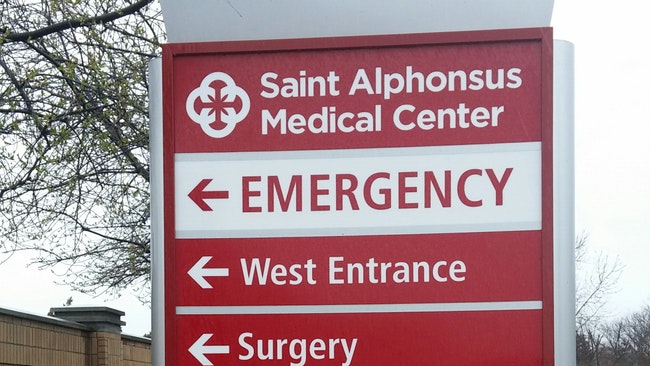
A recent health study conducted by the Saint Alphonus Health System lists affordable housing as a key problem for residents in Washington, Payette and Malheur counties. (The Enterprise/File).
ONTARIO – Residents living in the western Treasure Valley face unique health needs and only a unified effort will resolve them, according to a recent study released by the Saint Alphonsus Health System.
The 2020 Community Health Needs Assessment listed a scarcity of affordable and available housing, lack of financial stability and mental health needs as the top three community health problems in Washington, Payette and Malheur counties.
The assessment was the work of a 19-member advisory committee consisting of local people and 12 area organizations and used information gathered from focus groups, interviews and a survey of residents to assemble the study.
The aim of the analysis is to identify the needs of, and advocate for, individuals on the “margins of society,” in the western Treasure Valley.
The information was gathered toward the end of 2019, said Ken Hart, president of Saint Alphonsus Medical Center Ontario.
In February, the advisory committee met to discuss the initial results of the assessment and then ranked key area health needs. Along with with housing, financial stability and mental health, other top health needs identified include:
– Substance abuse, including tobacco and vape.
– Childcare and education.
– Access to healthcare, including oral healthcare.
– Chronic diseases.
– Wages and job availability.
– Sexually transmitted infections.
– Access to birth control and teen pregnancy.
– Food security.
– Transportation.
– Physical activity and recreation opportunities.
Hart said the information in the assessment helps direct the hospital’s leadership team on “this is what the community says we need and how are we responding to it.”
“We use this as a road map and will use it for the next three years to guide our decisions for the hospital and the (hospital) foundation. We pulled a lot of data from different sources,” said Hart.
Community health combines an array of environmental, social and economic issues, said Hart. Housing challenges locally are a good example, he said.
“If someone is in here with respiratory issues and we continue to send them back to their homes with black mold, they will continue to come in. More and more people see that housing does have an impact on community health and well-being,” said Hart.
Scarce housing was “seen as a growing issue among people coming to the Ontario region from Boise and surrounding areas,” according to the report.
“The No. 1 thing you hear from people when you are recruiting is it is hard to find housing in Ontario,” said Hart.
Financial stability is another factor to community health and the local area continues to struggle, according to the report.
Poverty – especially in Malheur County – haunts the western Treasure Valley, the report said, and ties in to a person’s ability to afford health care, food and housing.
“In 2018 the percent of population at or below the 200% Federal Poverty Level ranged from 37% in Payette County to almost 48% in Malheur County,” according to the report.
The report showed that almost half of the people in the area make “too much to qualify for many subsidies, but not enough to make ends meet.”
Sarah Poe, Malheur County Health Department director, said financial stability is the No. 1 issue for Malheur County.
“It impacts everything else,” said Poe.
A difference in the minimum wage between Oregon and Idaho plays a role on the overall financial stability locally, said the report.
The minimum wage in Oregon – $11.50 for non-urban areas such as Ontario – is $4 higher than the $7.25 basic wage in Idaho.
“Participants spoke about how it was not uncommon to see people living in Idaho but working in Oregon because the difference in wages is so great,” the report said.
To address that issue on a national level, Hart said Trinity Health created a living wage “as opposed to the minimum wage.”
“We’ve established a living wage floor that is higher than the minimum wage,” said Hart.
The Trinity Health wage initiative is especially helpful in Idaho where the wage disparity plays a role in financial stability.
About 40 percent of those surveyed plus interviews and focus group participants listed mental health as a top issue for the local area.
Financial stress “seemed to be the major cause of mental health problems in the community that participants identified,” according to the study.
A dearth of mental health facilities to care for people was also seen to be a major problem across the western Treasure Valley.
“Currently, there are no facilities in the assessment region to care for people in crisis. Participants said their two options for treatment are either the ER, or a number of facilities that are several miles outside the assessment region,” said the report.
Hart said the hospital often is on the front line of mental health issues.
“Many folks come in to our emergency room and have a medical issue and they have a mental issue so we have to address the mental health issue,” said Hart.
Hart said the hospital inked a contract with Lifeways to help address mental health issues that surface with patients at the hospital.
The report said the “Ontario region generally has positive health outcomes,” but the assessment “revealed various areas of need and opportunity in the community.”
A solution to the community health problems will take “collective action and community buy-in will be paramount,” the report stated.
A collective effort to address the health needs is already going on, said Rebecca Lemmons, manger of the Saint Alphonsus Health System Community Health and Well-Being Department.
Lemmons helped spearhead the health assessment.
A “whole number of organizations depending on the topic” are involved in addressing the issues outlined in the report, said Lemmons.
“For example, the city of Ontario has been at the table for many of the housing issues,” said Lemmons.
The work on the study also helped “get people in the same room” to discuss the area’s health challenges.
“You bring lots of people to the table who have lots of different resources,” said Lemmons.
Lemmons said the collective effort to tackle area health needs includes cities, non-profits, schools and other health care institutions.
“Ontario is small enough and connected enough that people are able to come together to work on these bigger, stickier issues,” said Lemmons.
Poe said one takeaway from the report is health in the county has not improved for the majority of residents.
Poe said more work is needed across a swath of different health categories including education, incomes, jobs, housing, sex education and birth control.
“We still need more citizens to act as advocates in community health efforts like this,” said Poe.
Hart said he believes the top health issue is lack of housing.
“How do we have good, clean and safe housing for folks? How do we work together to address housing needs?” said Hart.
Lemmons said the primary health challenges in the report remain essentially the same across the Treasure Valley.
“The top needs didn’t change or shuffle a whole lot across the areas and we are seeing that these things are increasing even more,” said Lemmons.
News tip? Contact reporter Pat Caldwell at [email protected] or 541-473-3377.
KEEP THE ENTERPRISE GOING AS OTHERS CLOSE…..
Reader support allows the Enterprise to provide in-depth, accurate reporting that otherwise would not get done. Keeping the community well informed is essential. SUBSCRIBE – $5 a month, automatically. DONATE – to provide additional support.




